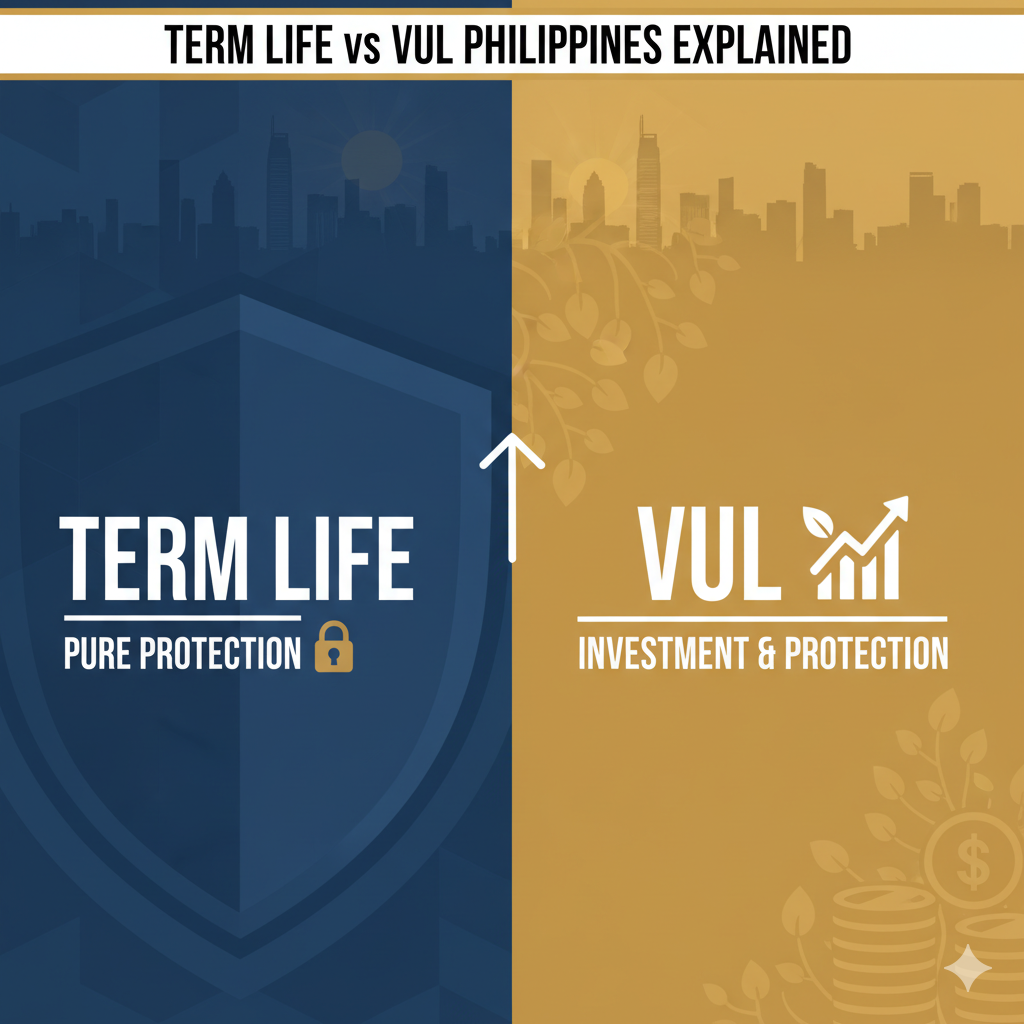Term life or VUL? A clear, practical guide for Filipino savers
If you’re researching life insurance options and feel stuck between straightforward protection and an investment-linked plan, this guide will help. In this article we’ll break down term life vs VUL philippines explained in plain language so you can match the product to your goals.
Many Filipinos ask whether to buy pure protection or a combo product that grows cash value. This piece answers that core question: term life vs VUL philippines explained — what each does, how much they cost, and who benefits most.
By the end you’ll have a one-page decision checklist and FAQs to take to your adviser. We’ll keep the comparison practical: term life vs VUL philippines explained with clear pros, cons and real-world trade-offs.
What is term life and who is it for?
Term life is pure protection: you pay a relatively low premium for a fixed death benefit that lasts a set number of years. If you stop paying, coverage stops — there’s no cash value or investment component. Term policies are designed to deliver the largest death benefit for the smallest premium, making them ideal for young families or people on a budget who want straightforward protection. Evidence from local insurer comparisons shows term is typically much cheaper than investment-linked alternatives. financeinaminute.com
What is VUL (Variable Universal Life) and how it works
VUL mixes life cover with an investment account: part of your premium funds the insurance, while the remainder is invested in sub-accounts (equity, bond-style funds, etc.). That means the policy develops a cash value you can borrow against, withdraw, or use to pay future premiums — but the cash value and sometimes the death benefit depend on market performance. Insurers in the Philippines describe VUL as a flexible but more complex product that requires investors to accept market risk. bpi-aia.com.ph
Quick comparison: term life vs VUL philippines explained (at a glance)
-
Cost: Term = lower premiums; VUL = higher (insurance + fees + fund management). wwwallianzpnblifeph
-
Purpose: Term = pure protection. VUL = protection + investment. bpi-aia.com.ph
-
Risk: Term = no investment risk. VUL = exposure to market volatility (fund losses possible). AIA Philippines
-
Flexibility: Term = simple, set cover. VUL = flexible premiums and benefit options, but complexity increases. bpi-aia.com.ph
-
Liquidity / cash value: Term = none. VUL = yes, but withdrawals/loans can reduce death benefit and may incur fees. wwwallianzpnblifeph
Fees, surrender charges and the fine print
VUL policies carry more moving parts: fund management fees, policy admin fees, early surrender charges and insurance loads. Some local guides and insurers warn surrender fees can apply for many years (reducing early cash-out value), and overall charges make the early years of a VUL inefficient as an investment. If you plan to access the money within 5–10 years, VUL often underperforms simple investment accounts after fees. wwwallianzpnblifeph
Philippine tax & estate-note (short)
Life insurance proceeds delivered directly to a named beneficiary are generally not treated the same as other estate assets for estate-tax computation — but the tax treatment depends on ownership and whether the beneficiary designation is irrevocable. For estate-planning uses, naming an irrevocable beneficiary (or proper ownership structuring) can keep proceeds out of the taxable gross estate under Philippine rules — important when you plan payouts for heirs. Always confirm details with a tax adviser or insurer. insurance.gov.ph
Which should you pick? (practical decision checklist)
Choose term life if:
-
Your primary goal is affordable income replacement or mortgage protection.
-
You want the cheapest way to get a large death benefit.
-
You prefer a simple product with no investment exposure.
Choose VUL if:
-
You want life protection and are comfortable with market risk.
-
You plan to invest long-term (10+ years) and accept fees in exchange for convenience and potential tax/legacy benefits.
-
You understand fund options and can review performance regularly. AIA Philippines
Pro tip: many Filipinos follow “buy term, invest the difference” (BTID) — buy a low-cost term policy and put the savings into mutual funds or ETFs. That often gives better investment results with more transparency — but it requires discipline and separate account administration. AETOS Financial
Short FAQ (for SEO & readers)
Q: Is VUL always better than term life?
A: No. VUL adds investment risk and fees; it’s better only if you want the combined product and plan long-term. bpi-aia.com.ph
Q: Can I switch from VUL to term later?
A: Some insurers allow adjustments, but switching may trigger charges and underwriting; compare the costs carefully.
Q: Will my beneficiaries pay income tax on life insurance proceeds?
A: Death benefits are generally not treated as taxable income, but estate tax inclusion depends on ownership and beneficiary designation — consult the insurer or tax counsel. insurance.gov.ph
SEO notes & quick publishing checklist (what I’d optimize if you publish this)
-
Target keyword: term life vs VUL philippines explained (use exact phrase 7× across page — intro 3×, body 1×, conclusion 3×).
-
Suggested H1: Term Life or VUL in the Philippines — which should you choose?
-
Meta description: Short, benefit-driven (under 155 chars).
-
LSI / supporting keywords: VUL insurance Philippines, term life insurance Philippines, VUL vs term, buy term invest the difference, VUL fees surrender charges.
-
Content intent: transactional/informational — people comparing products before buying. Use buyer-intent CTAs: “Compare quotes”, “Ask an adviser”, “Download checklist”.
-
Internal links: link to product comparison pages, insurer FAQ pages (Sun Life, AIA, BPI/AIA), estate planning article.
-
External authority links: link to insurer VUL explainer pages and Insurance Commission / BIR documents (we cited these).
-
Schema: Use FAQ schema for the FAQ section and Article schema with target keyword in headline.
Conclusion
If you need affordable, no-frills protection, term life vs VUL philippines explained usually points to term life as the best starter option for straightforward coverage. If you want protection plus an investment wrapper and accept market risk and fees, term life vs VUL philippines explained will often point you toward VUL — but only if you plan long-term and understand costs. For most people who want both safety and better investment control, the decision can be: buy term and invest the difference, or pick a VUL only after comparing fees and fund performance. Ultimately, term life vs VUL philippines explained comes down to purpose: protection now (term) vs protection + investment (VUL).


